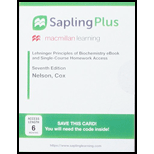
Concept explainers
(a)
To determine: The Lk of a 5000 bp circular duplex DNA molecule with a nick in one strand.
Introduction:
Linking number (Lk) is a topological characteristic of a DNA molecule. It determines the numbers of helical turns within a closed-circular DNA molecule without any supercoiling. It does not vary whether the DNA is deformed or bent. It causes both DNA strands to remain intact.
(b)
To determine: The Lk of a
Introduction:
Linking number does not vary, as long as both strands of DNA molecule remain intact. It defines the number of times in which each strand is underwinds around each other. During the relaxed form, the linkage number (Lk) is equal to the number of turns found in the DNA double helix.
(c)
To determine: The way through which Lk of a 5’000 bp circular DNA duplex when it is in relaxed form, would be affected by the action of a single molecule of E. coli topoisomerase I.
Introduction:
Topoisomers are formed when two forms of a given circular DNA molecule differ only in a topological characteristic. Topoisomerase enzymes can increase or reduce the numbers of DNA underwinding. They can also influence the topological characteristics.
(d)
To determine: The Lk of a 5,000 bp circular DNA duplex molecule after eight enzymatic turnovers by a single molecule of DNA gyrase in the presence of ATP.
Introduction:
DNA topoisomerase causes the reduction in topological stress that is formed during the strand separation within the DNA by helicases.
(e)
To determine: Lk of a 5000 bp circular DNA duplex molecule be after four enzymatic turnovers by a single molecule of bacterial type I topoisomerase.
Introduction:
Type I topoisomerase break one strand of double helical DNA molecule. The unbroken strand is further transferred to the single stranded breaks, and resealed.
(f)
To determine: The Lk of a 5000 bp circular DNA duplex molecule be after binding of one nucleosome core.
Introduction:
When a protein complex is associated for forming a nucleosome, the linking number does not change because the strand of DNA does not break and rejoin.
Want to see the full answer?
Check out a sample textbook solution
Chapter 24 Solutions
SaplingPlus for Lehninger Principles of Biochemistry (Six-Month Access)
- The following data were recorded for the enzyme catalyzed conversion of S -> P. Question: Estimate the Vmax and Km. What would be the rate at 2.5 and 5.0 x 10-5 M [S] ?arrow_forwardPlease helparrow_forwardThe following data were recorded for the enzyme catalyzed conversion of S -> P Question: what would the rate be at 5.0 x 10-5 M [S] and the enzyme concentration was doubled? Also, the rate given in the table is from product accumulation after 10 minuets of reaction time. Verify these rates represent a true initial rate (less than 5% turnover). Please helparrow_forward
- The following data was obtained on isocitrate lyase from an algal species. Identify the reaction catalyzed by this enzyme, deduce the KM and Vmax , and determine the nature of the inhibition by oxaloacetate. Please helparrow_forwardIn the table below, there are sketches of four crystals made of positively-charged cations and negatively-charged anions. Rank these crystals in decreasing order of stability (or equivalently increasing order of energy). That is, select "1" below the most stable (lowest energy) crystal. Select "2" below the next most stable (next lowest energy) crystal, and so forth. A B 鹽 (Choose one) +2 C +2 +2 (Choose one) D 鹽雞 (Choose one) (Choose one)arrow_forward1. Draw the structures for the fats A. 16:2: w-3 and B. 18:3:49,12,15 2. Name each of the molecules below (image attached)arrow_forward
- draw the structures for the fats A. 16:2:w-3 B 18:3:9,12,15arrow_forward1. Below is a template strand of DNA. Show the mRNA and protein that would result. label the ends of the molecules ( refer to attached image)arrow_forwardAttach the followina labels to the diagram below: helicase, single stranded binding proteins, lagging strand, leading strand, DNA polymerase, primase, 5' ends (3), 3' ends (3) (image attached)arrow_forward
- 1. How much energy in terms of ATP can be obtained from tristearin (stearate is 18:0) Show steps pleasearrow_forwardMultiple choice urgent!!arrow_forward1. Write the transamination reaction for alanine. Indicate what happens next to each of the molecules in the reaction, and under what conditions it happens. 2.arrow_forward
 BiochemistryBiochemistryISBN:9781319114671Author:Lubert Stryer, Jeremy M. Berg, John L. Tymoczko, Gregory J. Gatto Jr.Publisher:W. H. Freeman
BiochemistryBiochemistryISBN:9781319114671Author:Lubert Stryer, Jeremy M. Berg, John L. Tymoczko, Gregory J. Gatto Jr.Publisher:W. H. Freeman Lehninger Principles of BiochemistryBiochemistryISBN:9781464126116Author:David L. Nelson, Michael M. CoxPublisher:W. H. Freeman
Lehninger Principles of BiochemistryBiochemistryISBN:9781464126116Author:David L. Nelson, Michael M. CoxPublisher:W. H. Freeman Fundamentals of Biochemistry: Life at the Molecul...BiochemistryISBN:9781118918401Author:Donald Voet, Judith G. Voet, Charlotte W. PrattPublisher:WILEY
Fundamentals of Biochemistry: Life at the Molecul...BiochemistryISBN:9781118918401Author:Donald Voet, Judith G. Voet, Charlotte W. PrattPublisher:WILEY BiochemistryBiochemistryISBN:9781305961135Author:Mary K. Campbell, Shawn O. Farrell, Owen M. McDougalPublisher:Cengage Learning
BiochemistryBiochemistryISBN:9781305961135Author:Mary K. Campbell, Shawn O. Farrell, Owen M. McDougalPublisher:Cengage Learning BiochemistryBiochemistryISBN:9781305577206Author:Reginald H. Garrett, Charles M. GrishamPublisher:Cengage Learning
BiochemistryBiochemistryISBN:9781305577206Author:Reginald H. Garrett, Charles M. GrishamPublisher:Cengage Learning Fundamentals of General, Organic, and Biological ...BiochemistryISBN:9780134015187Author:John E. McMurry, David S. Ballantine, Carl A. Hoeger, Virginia E. PetersonPublisher:PEARSON
Fundamentals of General, Organic, and Biological ...BiochemistryISBN:9780134015187Author:John E. McMurry, David S. Ballantine, Carl A. Hoeger, Virginia E. PetersonPublisher:PEARSON





